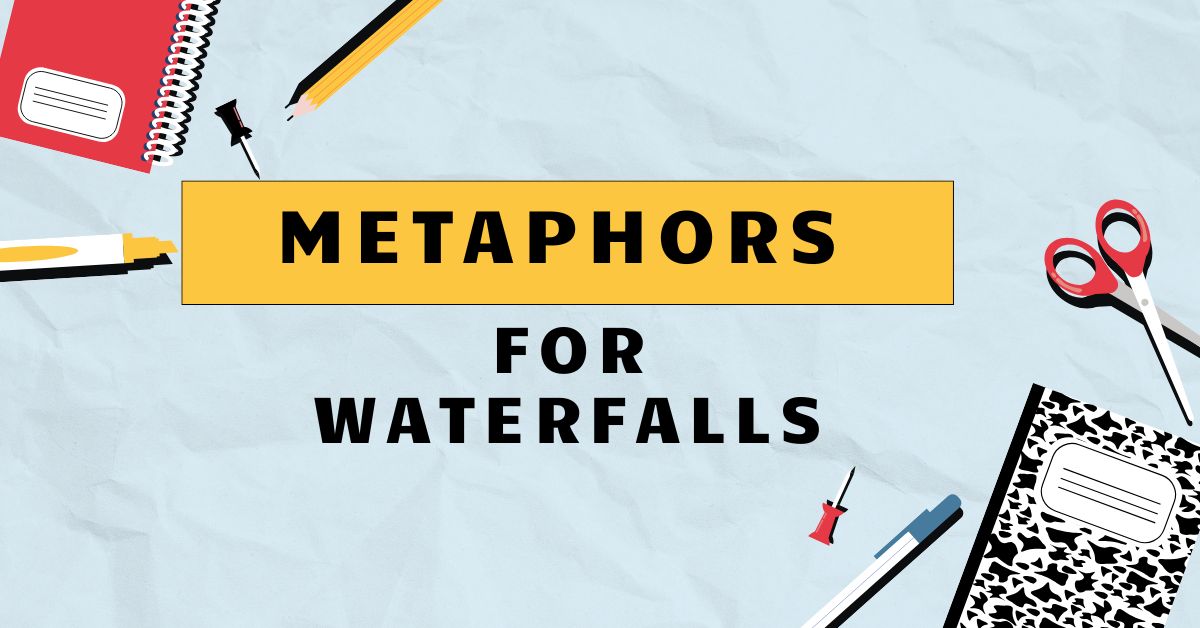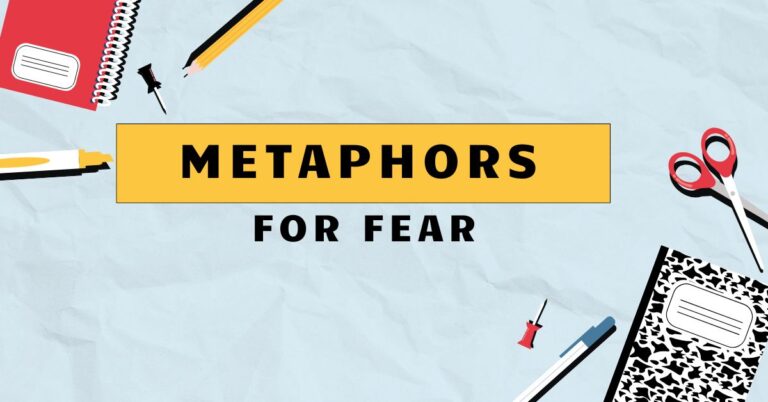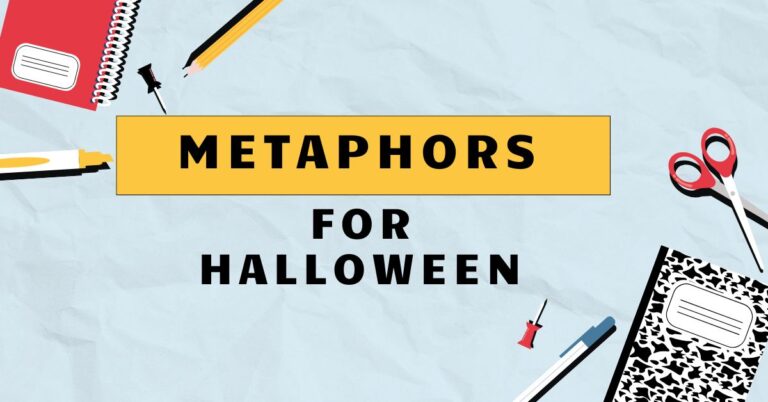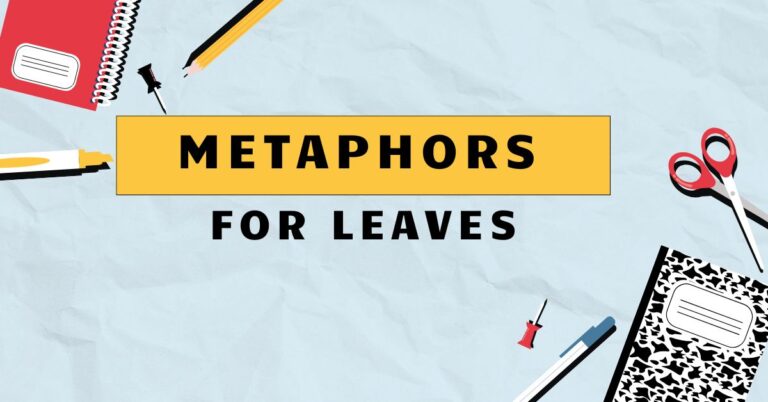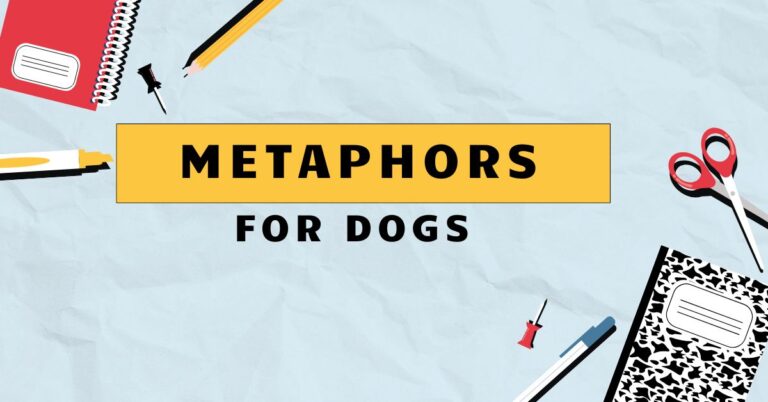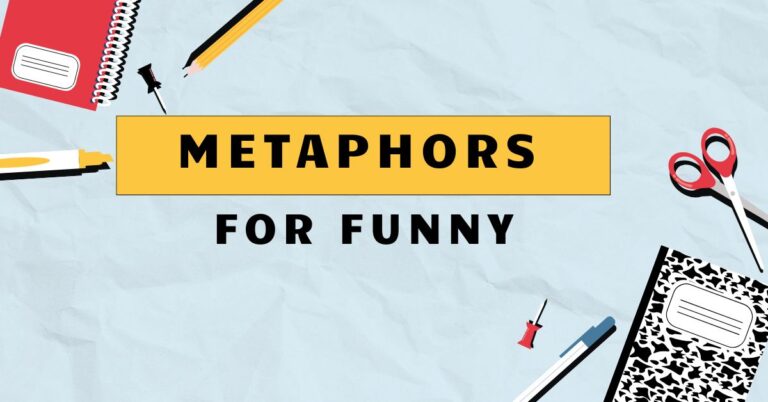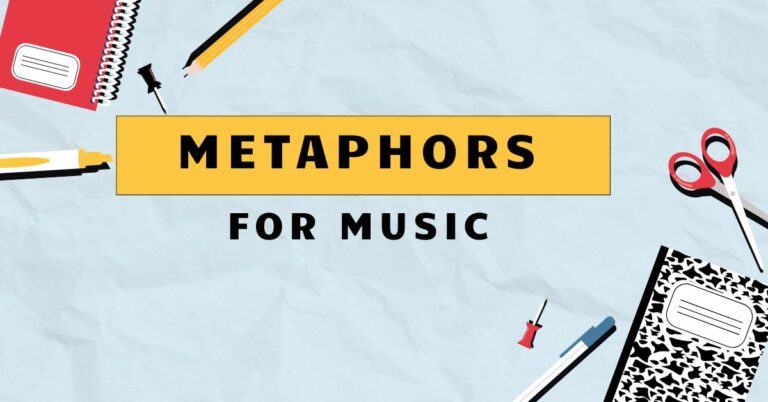49 Metaphors for Waterfalls: Enhancing Descriptive Language
Understanding metaphors for waterfalls enriches your descriptive writing and adds depth to your communication. Metaphors allow you to paint vivid pictures with words, transforming a simple image into something more profound and evocative.
This article delves into the world of waterfall metaphors, exploring their structure, types, and usage. Whether you’re a student, writer, or language enthusiast, this guide will equip you with the tools to master this powerful literary device.
Learning to use metaphors effectively will elevate your writing and allow you to express complex ideas in a more engaging and memorable way.
Table of Contents
- Definition of Metaphor
- Structural Breakdown of Waterfall Metaphors
- Types of Waterfall Metaphors
- Examples of Waterfall Metaphors
- Usage Rules for Waterfall Metaphors
- Common Mistakes with Waterfall Metaphors
- Practice Exercises
- Advanced Topics in Waterfall Metaphors
- FAQ: Frequently Asked Questions
- Conclusion
Definition of Metaphor
Ametaphoris a figure of speech that directly compares two unrelated things, asserting that one thing *is* another. It does so without using words like “like” or “as,” which are characteristic of similes.
The purpose of a metaphor is to create a vivid image or convey a deeper meaning by highlighting shared qualities between the two seemingly disparate entities. Metaphors are essential tools in literature, poetry, and everyday language, adding richness and nuance to communication.
In the context of waterfalls, metaphors can transform our perception of these natural wonders. Instead of merely describing their physical attributes – height, volume, speed – metaphors allow us to imbue waterfalls with symbolic meaning, emotional resonance, and imaginative associations.
They can be portrayed as symbols of power, grace, time, or even emotional states, depending on the specific metaphor employed.
Classification of Metaphors
Metaphors can be classified into several types based on their structure and function:
- Standard Metaphors: Explicitly state the comparison (e.g., “The waterfall is a liquid curtain”).
- Implied Metaphors: The comparison is suggested rather than directly stated (e.g., “The water roared down the cliff,” implying the waterfall is a powerful beast).
- Mixed Metaphors: Combine two or more inconsistent metaphors (generally considered poor writing).
- Extended Metaphors: A metaphor that is developed over several lines or paragraphs.
Function of Metaphors
The primary function of a metaphor is to create a figurative association between two unlike things to enhance understanding or create a specific effect. Metaphors can:
- Add vividness and imagery to writing.
- Convey complex ideas in a simpler, more relatable way.
- Evoke emotions and create a specific mood.
- Provide new perspectives and insights into a subject.
Contexts for Using Waterfall Metaphors
Waterfall metaphors can be used in various contexts:
- Literature: To add depth and symbolism to descriptions.
- Poetry: To evoke emotions and create powerful imagery.
- Descriptive Writing: To make writing more engaging and memorable.
- Everyday Speech: To add color and expressiveness to communication.
Structural Breakdown of Waterfall Metaphors
Understanding the structure of a metaphor is crucial for effective usage. A metaphor typically consists of two main elements: thetenorand thevehicle.
The tenor is the subject being described (in this case, the waterfall), and the vehicle is the object or concept used to describe it.
For example, in the metaphor “The waterfall is a liquid staircase,” the tenor is the waterfall, and the vehicle is a liquid staircase. The shared quality being highlighted is the cascading, step-like descent of the water.
The effectiveness of a metaphor depends on the strength of the connection between the tenor and the vehicle. A strong metaphor creates a clear and meaningful association, while a weak metaphor can be confusing or ineffective.
Consider the following elements when constructing waterfall metaphors:
- Visual Similarity: Does the vehicle share visual characteristics with the waterfall (e.g., shape, color, movement)?
- Auditory Similarity: Does the vehicle evoke similar sounds to the waterfall (e.g., rushing, roaring, whispering)?
- Emotional Association: Does the vehicle elicit similar emotions to the waterfall (e.g., awe, tranquility, fear)?
- Symbolic Meaning: Does the vehicle carry symbolic weight that enhances the meaning of the waterfall (e.g., power, purity, transience)?
Types of Waterfall Metaphors
Waterfall metaphors can be categorized based on the specific qualities or characteristics they emphasize. Here are some common types:
Metaphors for Power and Force
These metaphors emphasize the raw energy and forceful nature of waterfalls. They often use vehicles such as:
- Beasts: “The waterfall is a roaring lion.”
- Weapons: “The waterfall is a liquid battering ram.”
- Natural Disasters: “The waterfall is a torrential downpour unleashed.”
Metaphors for Fluidity and Grace
These metaphors highlight the smooth, flowing movement of waterfalls. They often use vehicles such as:
- Dancers: “The waterfall is a graceful dancer.”
- Fabrics: “The waterfall is a silken curtain.”
- Liquids: “The waterfall is a river of mercury.”
Metaphors for Sound and Music
These metaphors focus on the auditory experience of waterfalls. They often use vehicles such as:
- Musical Instruments: “The waterfall is a crashing symphony.”
- Voices: “The waterfall is a whispering giant.”
- Noises: “The waterfall is a constant rumble.”
Metaphors for Time and Eternity
These metaphors connect waterfalls to the concept of time, highlighting their constant flow and enduring presence. They often use vehicles such as:
- Rivers of Time: “The waterfall is a river of time cascading into the present.”
- Eternal Cycles: “The waterfall is an eternal cycle of water and stone.”
- Moments Frozen: “The waterfall is a moment frozen in perpetual motion.”
Metaphors for Emotion and Feeling
These metaphors associate waterfalls with specific emotions, reflecting their impact on the human psyche. They often use vehicles such as:
- Tears: “The waterfall is a weeping cascade of sorrow.”
- Joy: “The waterfall is a joyous outpouring of energy.”
- Peace: “The waterfall is a tranquil stream of serenity.”
Examples of Waterfall Metaphors
Here are examples of waterfall metaphors, categorized by the qualities they emphasize.
Examples Emphasizing Power
These metaphors highlight the immense force and energy of waterfalls.
| Metaphor | Explanation |
|---|---|
| The waterfall is a liquid hammer, pounding the rocks below. | Emphasizes the forceful impact of the water. |
| The waterfall is a roaring beast, unleashing its fury on the landscape. | Compares the waterfall to a powerful, untamed animal. |
| The waterfall is a surging wave of liquid muscle. | Highlights the sheer strength and volume of the water. |
| The waterfall is a thunderous avalanche of water. | Connects the waterfall to the destructive power of an avalanche. |
| The waterfall is a relentless torrent, carving its path through the stone. | Emphasizes the unstoppable nature of the water. |
| The waterfall is nature’s hydraulic press, shaping the valley over millennia. | Highlights the waterfall’s long-term erosive power. |
| The waterfall is a liquid earthquake, shaking the ground with its force. | Associates the waterfall with seismic energy. |
| The waterfall is a watery fist crashing down on the earth. | Creates a strong image of forceful impact. |
| The waterfall is a liquid explosion, spraying mist in every direction. | Emphasizes the explosive power of the water’s descent. |
| The waterfall is a powerful engine, driving the river’s ecosystem. | Highlights the waterfall’s role in the river’s energy cycle. |
| The waterfall is a natural dam breaker, releasing pent-up energy. | Compares the waterfall to a controlled release of power. |
| The waterfall is a liquid bulldozer, clearing debris from its path. | Emphasizes the waterfall’s ability to move obstacles. |
| The waterfall is a watery giant, flexing its muscles for all to see. | Personifies the waterfall as a powerful being. |
| The waterfall is a roaring flood compressed into a single stream. | Highlights the concentrated force of the water. |
| The waterfall is a liquid cannon, blasting the rocks with its spray. | Compares the waterfall to a weapon of force. |
| The waterfall is a violent outpouring of nature’s energy. | Emphasizes the raw and untamed power of the waterfall. |
| The waterfall is a liquid volcano, spewing water instead of lava. | Connects the waterfall to volcanic power. |
| The waterfall is a force of nature, demanding respect and awe. | Highlights the waterfall’s commanding presence. |
| The waterfall is a powerful reminder of nature’s untamed strength. | Emphasizes the humbling effect of the waterfall’s power. |
| The waterfall is an unstoppable force, forever shaping the landscape. | Highlights the waterfall’s enduring power. |
| The waterfall is a liquid war cry, echoing through the valley. | Associates the waterfall with a primal expression of power. |
| The waterfall is a liquid battering ram against the face of the cliff. | Highlights the direct and forceful impact of the water. |
| The waterfall is a powerful pulse, throbbing with the earth’s lifeblood. | Connects the waterfall to the planet’s vital energy. |
Examples Emphasizing Fluidity
These metaphors focus on the smooth, graceful movement of waterfalls.
| Metaphor | Explanation |
|---|---|
| The waterfall is a liquid ribbon, gracefully unfurling down the cliff. | Highlights the smooth, flowing appearance of the water. |
| The waterfall is a dancer, twirling and leaping down the rocks. | Compares the waterfall to a graceful performer. |
| The waterfall is a silken veil, cascading gently over the edge. | Emphasizes the soft, delicate texture of the water. |
| The waterfall is a liquid melody, flowing seamlessly from above. | Connects the waterfall to the smooth, harmonious quality of music. |
| The waterfall is a gentle cascade, whispering secrets to the stones below. | Highlights the soft, subtle movement of the water. |
| The waterfall is a liquid staircase, leading to a hidden realm. | Emphasizes the step-like descent of the water. |
| The waterfall is a graceful streamer, unfurling in the breeze. | Compares the waterfall to a flowing banner. |
| The waterfall is a liquid braid, intricately woven from countless droplets. | Highlights the complex structure of the water’s flow. |
| The waterfall is a flowing tapestry, embroidered with light and shadow. | Connects the waterfall to a rich, textured work of art. |
| The waterfall is a liquid sigh, exhaled from the heart of the mountain. | Emphasizes the gentle, breath-like quality of the water. |
| The waterfall is a graceful swan diving into a crystal lake. | Compares the waterfall to a majestic bird in motion. |
| The waterfall is a liquid pendulum, swinging between the sky and the earth. | Highlights the rhythmic movement of the water. |
| The waterfall is a flowing sculpture, carved by the hands of time. | Connects the waterfall to a timeless work of art. |
| The waterfall is a liquid embrace, enveloping the rocks in its cool spray. | Emphasizes the gentle, comforting sensation of the water. |
| The waterfall is a graceful descent, a journey from mountain to valley. | Highlights the continuous flow of the water. |
| The waterfall is a liquid dance, a rhythmic ballet of water and stone. | Compares the waterfall to a choreographed performance. |
| The waterfall is a flowing river of dreams, cascading into the unknown. | Connects the waterfall to the realm of imagination. |
| The waterfall is a liquid lullaby, soothing the earth with its gentle song. | Emphasizes the calming effect of the water. |
| The waterfall is a graceful curve, a perfect arc of liquid beauty. | Highlights the elegant shape of the water’s descent. |
| The waterfall is a flowing symphony, a harmonious blend of sight and sound. | Connects the waterfall to a rich, multi-sensory experience. |
| The waterfall is a liquid waterfall, an endless flow of purified water. | Highlights the purity and constant flow of the waterfall. |
| The waterfall is a flowing river, meandering through the landscape. | Compares the waterfall to a tranquil, flowing river. |
Examples Emphasizing Sound
These metaphors focus on the auditory experience of waterfalls.
| Metaphor | Explanation |
|---|---|
| The waterfall is a crashing cymbal, reverberating through the valley. | Emphasizes the loud, resonant sound of the water. |
| The waterfall is a whispering chorus, murmuring secrets to the forest. | Compares the waterfall to a soft, harmonious sound. |
| The waterfall is a roaring orchestra, conducting a symphony of nature. | Connects the waterfall to a powerful, complex musical performance. |
| The waterfall is a constant drone, a steady hum that fills the air. | Highlights the continuous, unwavering sound of the water. |
| The waterfall is a liquid drum, beating a primal rhythm against the rocks. | Compares the waterfall to a rhythmic, percussive sound. |
| The waterfall is a thundering applause, celebrating the power of nature. | Emphasizes the loud, celebratory sound of the water. |
| The waterfall is a whispering lullaby, soothing the earth to sleep. | Connects the waterfall to a soft, comforting sound. |
| The waterfall is a liquid fanfare, announcing the arrival of spring. | Compares the waterfall to a celebratory musical introduction. |
| The waterfall is a crashing wave of sound, engulfing the senses. | Emphasizes the overwhelming auditory experience of the water. |
| The waterfall is a whispering voice, sharing ancient stories with the wind. | Connects the waterfall to a soft, narrative sound. |
| The waterfall is a liquid bell, ringing out across the landscape. | Compares the waterfall to a clear, resonant sound. |
| The waterfall is a roaring siren, calling out to the wild. | Emphasizes the powerful, attention-grabbing sound of the water. |
| The waterfall is a crashing crescendo, building to a deafening climax. | Connects the waterfall to a dramatic musical progression. |
| The waterfall is a whispering prayer, carried on the breeze. | Compares the waterfall to a soft, spiritual sound. |
| The waterfall is a liquid echo, bouncing off the canyon walls. | Emphasizes the reverberating quality of the water’s sound. |
| The waterfall is a roaring lion, announcing its presence to the world. | Highlights the powerful, dominant sound of the water. |
| The waterfall is a crashing harp, playing a melody of water and stone. | Connects the waterfall to a delicate, harmonious sound. |
| The waterfall is a whispering secret, shared only with those who listen closely. | Compares the waterfall to a soft, intimate sound. |
| The waterfall is a liquid horn, sounding a call to adventure. | Emphasizes the bold, adventurous sound of the water. |
| The waterfall is a crashing opera, a dramatic performance of natural sound. | Connects the waterfall to a grand, theatrical musical experience. |
Usage Rules for Waterfall Metaphors
Using waterfall metaphors effectively requires adherence to certain rules:
- Clarity: The metaphor should be easily understood. Avoid obscure or overly complex comparisons.
- Relevance: The vehicle should have a clear connection to the tenor (the waterfall).
- Originality: Strive for fresh and imaginative metaphors. Avoid clichés.
- Consistency: Maintain a consistent tone and imagery throughout your writing.
- Context: Ensure the metaphor is appropriate for the context and audience.
Note: Overuse of metaphors can dilute their impact. Use them sparingly and strategically to enhance your writing.
Common Mistakes with Waterfall Metaphors
Here are some common mistakes to avoid when using waterfall metaphors:
| Mistake | Incorrect Example | Correct Example | Explanation |
|---|---|---|---|
| Mixed Metaphor | The waterfall is a roaring lion, but it also sings a sweet song. | The waterfall is a roaring lion, its voice echoing through the valley. | Avoid combining inconsistent images in a single metaphor. |
| Cliché | The waterfall is a curtain of water. | The waterfall is a liquid tapestry, woven with threads of sunlight. | Avoid overused and unoriginal metaphors. |
| Inappropriate Metaphor | The waterfall is a rusty cog in the machine of nature. | The waterfall is a powerful engine, driving the river’s ecosystem. | Ensure the metaphor is appropriate for the subject. |
| Unclear Metaphor | The waterfall is a quantum entanglement. | The waterfall is a mysterious force, connecting the mountain to the valley. | The metaphor should be easily understood. |
| Overuse of Metaphors | The waterfall is a dancer, a ribbon, a song, a dream. | The waterfall is a dancer, gracefully leaping down the rocks. | Avoid using too many metaphors in a short space. |
Practice Exercises
Test your understanding of waterfall metaphors with these exercises.
-
Exercise 1: Identify the Metaphor
Identify the metaphor in each sentence and explain its meaning.
Sentence Answer The waterfall is a liquid staircase, leading to a hidden pool. Metaphor: “liquid staircase.” Meaning: The waterfall resembles a staircase due to its stepped descent. The waterfall roared like a beast, its voice echoing through the canyon. Metaphor: “roared like a beast.” Meaning: The waterfall’s sound is powerful and animalistic. The waterfall is a silken veil, draped over the rugged cliffs. Metaphor: “silken veil.” Meaning: The waterfall appears smooth and delicate, like a veil. The waterfall is a river of time, flowing endlessly into the future. Metaphor: “river of time.” Meaning: The waterfall represents the continuous passage of time. The waterfall is a crashing symphony, a cacophony of natural sounds. Metaphor: “crashing symphony.” Meaning: The waterfall’s sound is complex and powerful, like an orchestra. The waterfall is nature’s tears, crying for the loss of the forest. Metaphor: “nature’s tears.” Meaning: The waterfall symbolizes sadness and grief. The waterfall is a liquid hammer, pounding the rocks into submission. Metaphor: “liquid hammer.” Meaning: The waterfall’s force is likened to a hammer. The waterfall is a whispering giant, sharing secrets with the wind. Metaphor: “whispering giant.” Meaning: The waterfall makes a soft noise despite its size. The waterfall is a flowing river of dreams, cascading into the unknown. Metaphor: “flowing river of dreams.” Meaning: The waterfall is mysterious and imaginative. The waterfall is a constant reminder of nature’s untamed power. Metaphor: “a constant reminder.” Meaning: The waterfall’s powerful presence is always felt. -
Exercise 2: Create Your Own Metaphors
Create three original metaphors for a waterfall, focusing on different aspects (power, fluidity, sound).
Aspect Your Metaphor Power The waterfall is a liquid fist, smashing against the earth. Fluidity The waterfall is a flowing ribbon of light, dancing in the sun. Sound The waterfall is a roaring trumpet, announcing nature’s majesty. -
Exercise 3: Correct the Mistakes
Identify and correct the mistakes in the following sentences.
Sentence Corrected Sentence The waterfall is a crashing symphony, but it also sleeps soundly. The waterfall is a crashing symphony, its music echoing through the valley. The waterfall is a curtain of water, like everyone says. The waterfall is a cascading cascade. The waterfall is a rusty nail in the foot of the mountain. The waterfall is a vein in the mountain. The waterfall is a quantum entanglement of H2O molecules. The waterfall is a mysterious stream. The waterfall is a dancer, a ribbon, a song, a flowing dream. The waterfall is a dancer, gracefully leaping down the rocks.
Advanced Topics in Waterfall Metaphors
For advanced learners, consider these more complex aspects of waterfall metaphors:
- Extended Metaphors: Developing a single metaphor throughout an entire poem or essay.
- Symbolic Metaphors: Using waterfalls to represent abstract concepts such as change, transformation, or the passage of time.
- Cultural Metaphors: Exploring how different cultures use waterfall metaphors to express unique perspectives and values.
By delving into these advanced topics, you can further enhance your understanding and appreciation of the power of waterfall metaphors.
FAQ: Frequently Asked Questions
- What is the difference between a metaphor and a simile?
A metaphor directly equates two things (e.g., “The waterfall is a liquid curtain”), while a simile uses “like” or “as” to make a comparison (e.g., “The waterfall is *like* a liquid curtain”).
- How can I avoid using clichés in my waterfall metaphors?
Brainstorm unique and unexpected connections between the waterfall and other objects or concepts. Focus on specific details and sensory experiences to create fresh imagery.
- What makes a metaphor “strong” or “weak”?
A strong metaphor creates a clear and meaningful association between the tenor and the vehicle, while a weak metaphor is confusing, irrelevant, or overused.
- Can I use multiple metaphors in a single sentence?
While possible, it’s generally best to avoid using too many metaphors in a single sentence, as it can become overwhelming and confusing. Focus on developing one strong metaphor instead.
- How do I choose the right metaphor for a specific context?
Consider the tone, audience, and purpose of your writing. Choose a metaphor that is appropriate for the context and effectively conveys the desired meaning or emotion.
- Are there any cultural differences in how waterfalls are used metaphorically?
Yes, different cultures may associate waterfalls with different symbols and meanings. Researching cultural perspectives can enrich your understanding and use of waterfall metaphors.
- How can I practice using waterfall metaphors?
Try writing descriptive passages about waterfalls, experimenting with different metaphors and imagery. Read examples of waterfall metaphors in literature and poetry to gain inspiration.
- What if my metaphor doesn’t make sense to everyone?
Metaphors are subjective, and not every metaphor will resonate with every reader. However, if a metaphor is consistently misunderstood, it may need to be revised for clarity.
- Can a waterfall be a metaphor for something other than power, fluidity, and sound?
Absolutely! Waterfalls can be metaphors for a wide range of concepts, including time, emotion, change, and resilience. The key is to find a meaningful connection between the waterfall and the concept you wish to convey.
Conclusion
Mastering metaphors for waterfalls is a valuable skill for enhancing your descriptive writing and communication. By understanding the structure, types, and usage rules of these metaphors, you can create vivid imagery, evoke emotions, and add depth to your language.
Remember to strive for clarity, originality, and consistency in your metaphors, and avoid common mistakes such as mixed metaphors and clichés. Practice regularly, and soon you’ll be able to craft compelling and unforgettable descriptions of these natural wonders.
The ability to use metaphors effectively is not just about grammar; it’s about creative expression and the power of language to transform our perceptions. So, go forth and explore the world of waterfall metaphors, and let your imagination flow like the cascading waters themselves.
By incorporating these techniques, you’ll not only improve your writing but also gain a deeper appreciation for the beauty and complexity of language.

